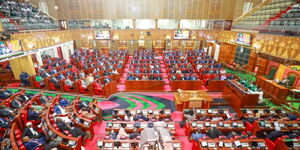The National Treasury is on the spot over a typing error that could have easily caused taxpayers billions.
This was after The first Quarterly Economic and Budgetary Review indicated the Treasury paid Sh8.6 billion interest to the UK, putting total bilateral debt service at Ksh41 billion.
However, it was established that Kenya did not have any pending loans with the UK and that the allocation of the funds was a product of a typographical error.
Kenya cleared the last credit owed to London in 2020 after it wired Ksh35.3 billion and has since not borrowed from the monarch, therefore, non-existent.
Officials at Treasury admitted to the error, explaining that although the money was rightfully listed, it was not allocated to the wrong recipient. Instead, it was to be used to to settle another debt owed by Kenya.
“It is a wrong classification of debt service on the table, it is supposed to be Eurobond payment, not UK debt,” stated the official in anonymity.
The money was to be channeled in the partial payment of the Eurobond loan as interest for the 10 and 30-year bonds borrowed in 2018. Consequently, the incident raised questions about the accuracy of data handled at Treasury.
The ministry has since pulled down the Quarterly Economic and Budgetary Review from its website upon an inquest into the matter.
Kenya has not taken any loans from Britain in the recent year, opting to borrow from the World Bank and the Department for International Development (DFID), now Foreign, Commonwealth and Development Office.
The incident raised fears of a repeat of a similar happening in 2009 when a typing error in the Ministry of Treasury led by then Cabinet Secretary, Uhuru Kenyatta, almost cost the country Ksh9.2 billion.
Currently, Kenya's debt stands at Ksh7.7 trillion with the lion's share owed domestically to local investors.
The Treasury is said to be pushing Members of Parliament to raise the debt ceiling from the current Ksh9 trillion to give more room for loans.












